Calvin: Why does the sky turn red as the sun sets?
Calvin's Dad: That's all the oxygen in the atmosphere catching fire.
Calvin: Where does the sun go when it sets?
Calvin's Dad: The sun sets in the west. In Arizona actually, near Flagstaff. That's why the rocks there are so red.
Calvin: Don't the people get burned up?
Calvin's Dad: No, the sun goes out as it sets. That's why it's dark at night.
Calvin: Doesn't the sun crush the whole state as it lands?
Calvin's Dad: Ha ha, of course not. Hold a quarter up. See, the sun's just about the same size.
Calvin: I thought I read that the sun was really big.
Calvin's Dad: You can't believe everything you read, I'm afraid. -Bill Watterson
But seriously, why is the Sun yellow?

This is particularly troubling, because when light shines on white things, they look white, not yellow! So what's going on with the Sun that makes it look yellow in the sky?
Let's remember how good the atmosphere is at tricking us about color, first. As example #1, I give you... the Moon!
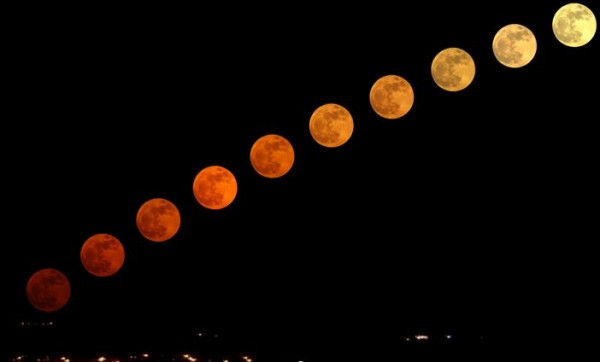
When the Moon is very, very low on the horizon, it has to pass through a huge amount of atmosphere! And what the Earth's atmosphere does -- thanks to a process called Rayleigh Scattering -- is to let the redder wavelengths of light through while scattering away the bluer ones.
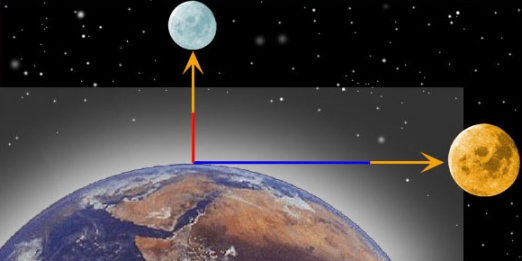
This is why not only the Moon appears redder when it's close to the horizon and whiter when it's high in the sky, but the Sun does as well!
The more atmosphere you pass the Sun through, the more blue light gets scattered away, and so the redder it appears! White light occurs when you get a roughly even mix of all the colors, but take some of the bluest blues away, and it'll turn yellow, orange, and eventually red as you progressively take more and more away.
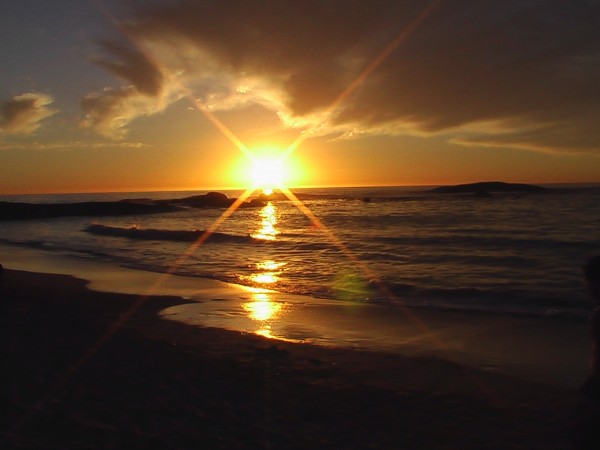
How to demonstrate this? This last picture gives me an idea.
Notice how the sunlight appears orange-ish, and the reflected sunlight also appears orange? This is because both the directly light from the sun and the reflected light from the water both pass through roughly the same amount of atmosphere.
But what if we went to space? We could compare the light reflected off of the Earth's oceans -- which passes through the atmosphere twice -- with the light directly from the Sun! Let's have a look:

The direct sunlight? Nearly perfectly white! But the light that passes through the Earth's atmosphere, reflects off the ocean, and heads back through the atmosphere to you? Yellow!
So that tells us that the atmosphere definitely makes the Sun look yellow to us. But what if we went to space, and took a good look at our Sun, and compared it with the other stars out there?
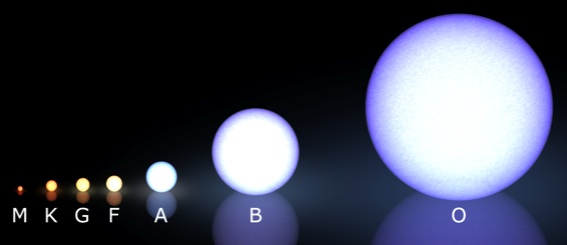
The Sun, although your eye isn't great at discerning it, is almost, but not perfectly white!
To an astronomer, if we want to know what colors come out of something, we imagine heating up something that's perfectly black to a ridiculously high temperature, and calculate what light would get emitted from it. We call this radiation, imaginatively, black body radiation. This has applications that range from estimating the temperature of lava,
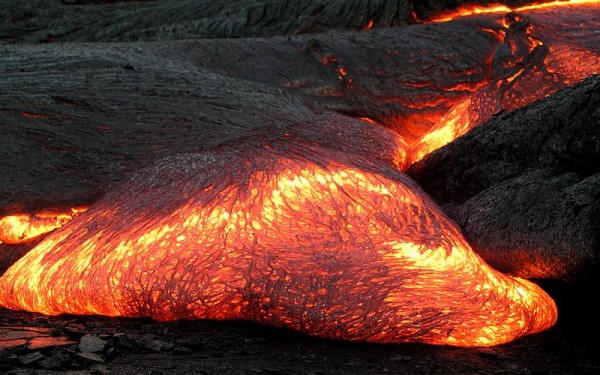
which is about 1300-1500 Kelvins, to the temperature of different stars! It turns out that each temperature has its own particular color, as illustrated by these three bulbs.
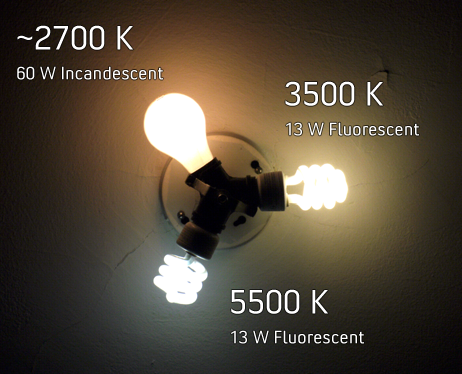
The one at 5500 Kelvin turns out to be very close to our Sun, but is only blue-ish by comparison with the other two bulbs. Our Sun, in reality, is actually at an average surface temperature of around 5700 Kelvin. You can see, by looking at the blackbody spectrum for a few different temperatures, why the cooler ones look redder and why the hotter ones look bluer.
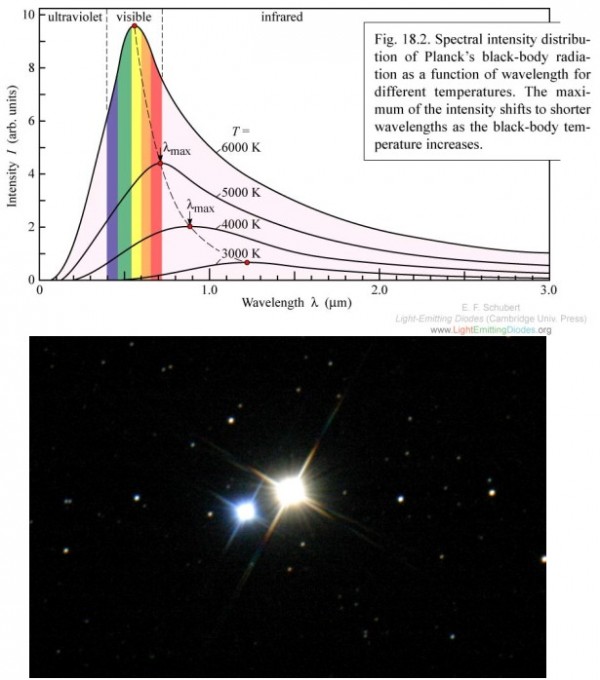
If a higher percentage of your visible light is red as compared to blue, you look redder, and vice versa! This means there are two ways to change your color, to either add more intensity of one type of light, or subtract out some light, like the atmosphere does to blue light!
In other words, it isn't just about how much red or blue light you have, it's how much you have relative to the other types!
If you were a perfect blackbody, the temperature would be the only thing that mattered in determining your color. And you would live, in color temperature world, on this black line in chromaticity space.
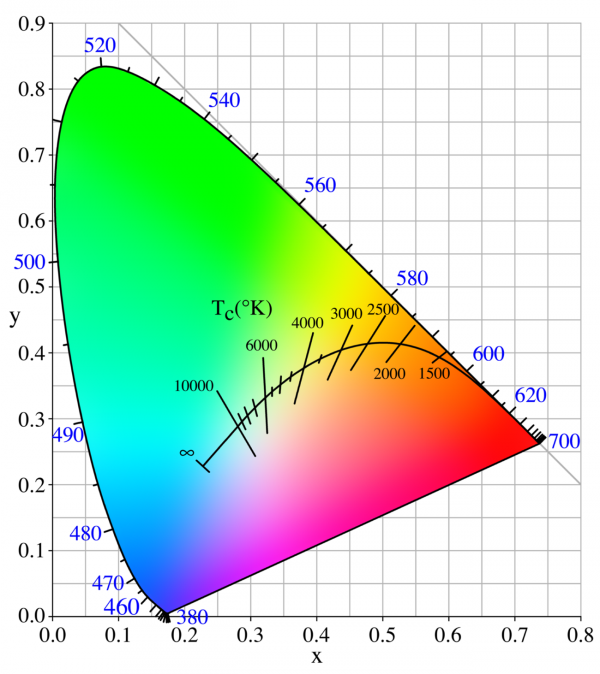
Of course, we don't. The Sun, after all, isn't black, and is powered by an awfully complicated process. It turns out that the real Sun has more blue light and more red light than a perfect blackbody, but less yellow and green light!
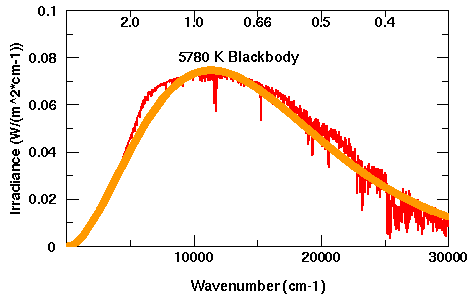
Why, you ask? We don't know. It might have something to do with how heat is generated in the Sun, the number of collisions it undergoes until it reaches the surface, uneven heating of the Sun's crust, or a multitude of other factors, but we don't know the whole story.
There are plenty of stars that are bluer than the Sun, and many, many more that are redder, but as far as we can tell, the true color of the Sun is almost perfectly white, but slightly more yellow/red than blue.
But -- and this is important -- not from the surface of the Earth! Our atmosphere turns direct sunlight slightly yellow! The effect is worse near sunrise or sunset, and is least at high noon on the summer solstice (when the Sun is nearest its zenith), but it's always present, and it always yellows the Sun slightly.
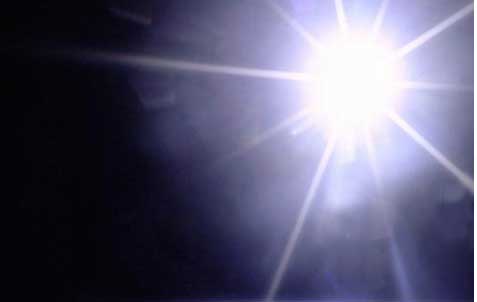
So if you want to see the whitest sunlight possible, space is your only option! Either than, or trade your eyes for an owl's (who'll see a blue Sun) or for a bee's (who'll see an orange one)!
Until then, enjoy the yellow one you've got, and thank our atmosphere for it!

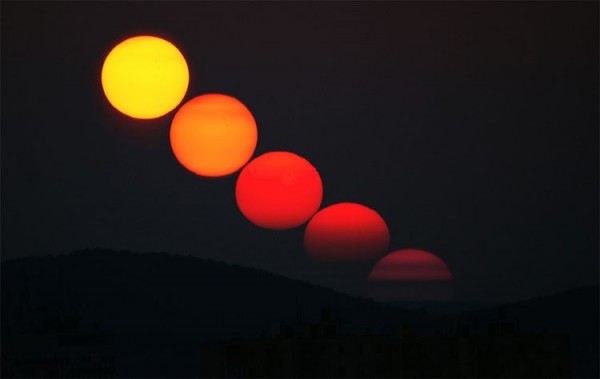
Wow, some beautiful pictures and well explained! The site below has a great animation that show the scattering process makes the sun look white in space, but yellow on the earth.
http://blogsworth.com/articles/why-is-the-sky-blue
awesome post, as always!
How did you discover this? How did you find out that the atmosphere changes the color of the light?
Would it be fair to say that "white" is purely an anthropomorphic construct? Our vision evolved in this spectral distribution of starlight â¦Â of course the light is "white". Right?
T'woof:
It seems to me that, since we have three cone types, one each for the primary colors, all three signals in equal strength from them would be combined in the brain, summing as white. Something like the phosphors on a TV tube's screen.
and
"The sun isn't yellow, it's chicken"
Tombstone Blues Bob Dylan [who else?]
The other noticeable effect of this, if I'm understanding correctly, is that the sky is blue. Those scattered bluer wavelengths are what we see elsewhere in the (clear) daytime sky, correct?
Perhaps you could tell us the story of black body radiation and the red hot fire poker story sometime in the near future. Neat post.
Birds and reptiles have four cone types, non-primate mammals two, so the different colors are probably "weighted" in a subtly different ways in their brains, but still ending up with sunlight being perceived as white.
BTW, since red light does not scatter well in the atmosphere, the sky of an exoplanet circling a cooler, redder star would be nearly dark, even at noon, and since the eye has to adapt to the brightest object around (the local sun), the contrasts would make the shadows very murky; shadows are illuminated by indirect, scattered light and would be darker than on Earth.
The sun has a crust? Interesting...
Rieux, that is correct. The blue light has been scattered out of the direct beam (which now looks a bit yellow) and so arrives at your eye from all directions.
If yellow or red light begins to get scattered out, this arrives at your eye from all directions, turning the sky a range of colours at sunrise/set.
One thing I've never figured out though is that if you're looking at a sunset with vivid yellow, orange and red splashed in front of you and blue behind, where's the vivid green!?
Exactly right.
Some hypothetical other intelligent species that evolved on this planet would see sunlight (not the Sun itself) as "white" regardless of what physiological differences they have in their vision, even if their vision lay outside our visible spectrum entirely.
(That said, colour vision is vastly more complex than just "what's the spectrum of the light entering the eye". The brain does huge amounts of post-processing work; the colours we see are essentially a reconstruction made by the brain based on differences in spectrum.)
If the light from the sun is making these colors before sunset then is it because of some kind of prism? and if so what would be big enough for the sun's light to refract on other then the atmosphere and if thats so then why would the atmosphere refract light?
Drew,
the atmosphere does refract light, because of density gradients (particularly density discontinuities, eg. temperature inversions). But this is not the cause of the light from the sun changing colour at sunset. As Ethan explains, that's due to Rayleigh scattering.
PS these refractions result in mirages, not prism-like effects.
A common form of refraction (but not producing a prism-like effect) can be seen during very cold days. On ordinary chilly, damp evenings, you will se a spherical halo around streetlights, but when it is really cold (and you get a temperature inversion near the ground) you get a "pillar of light" rising from the streetlights. This is because the temperature inversion makes the air preferentially refract light sideways, at an angle to the temperature gradient. Unfortunately, I do not know the details.
A similar kind of refraction also affect sound. This is why sound carries so far on cold days. Sound that should go upwards is deflected sideways.
--- --- ---
But I digress. What you really need to remember is Rayleigh scattering: It keeps the sky blue.
Maybe OT: Once, I saw a flash of green light above the sun just after it set (behind the ocean, in the Florida keys). What happened?
does the sun turning red have anything to do with the moon turning red?
what makes the sun turn yellow on earth and in space were it is white
That's so interesting! I wonder what other things that the atmosphere makes look a different color? Like are the other planets actually that color also?
When the Moon is very, very low on the horizon, it has to pass through a huge amount of atmosphere!
You might want to reword this.
The last information I read indicated that the peak emission wavelength from the sun was 540 nm. Wouldn't this indicate that the sun is green, our quirky and imperfect biological observation notwithstanding?
Phil Plait took on the green star bit a few years ago:
http://blogs.discovermagazine.com/badastronomy/2008/07/29/why-are-there…
@djlactin - What you probably witnessed is called "green flash". Due to the way that atmosphere deflects the different colours of sunlight, the Sun we see is actually a series of mostly-overlapping images of the Sun in different colours. The green flash occurs late in sunset when all but the green image of the Sun have sunk below the horizon; a tiny sliver of brilliant green light momentarily lingering just above the waves.
Right near the end of the article there's the phrase, "uneven heating of the Sun's crust," and it gave me some pause. The Sun's *crust*? You mean like the place where all those li'l SunCritters walk around and roast marshmallows and bask in Earthlight 'n such? It's hard for me to think of what would qualify as "the Sun's crust."
- MJM
You said:
"Why, you ask? We don't know. It might have something to do with how heat is generated in the Sun, the number of collisions it undergoes until it reaches the surface, uneven heating of the Sun's crust, or a multitude of other factors, but we don't know the whole story."
I don't understand this statement. Pick up any text on stellar atmospheres to find out why the Sun doesn't emit as a single-T blackbody. To a first approximation, the light emerges from a thin "skin" of gas, known as the photosphere that is in a condition known as "local thermodynamic equilibrium". That is, every layer within this skin emits locally as a blackbody at the local temperature T, which increases inward and decreases outward. So *we'd see a sum of blackbody radiation spectra* (each with its own value in T) weighted by a function that takes into account how light is absorbed by the matter locally. However, even the concept of local thermodynamic equilibrium isn't a good one to apply when studying the Sun's spectrum at any decent level of detail. And to understand that, you'd need to dig deeper into a graduate-level textbook on non-LTE stellar atmospheres.
And as for energy generation and transport within the Sun's interior -- these are hardly as mysterious as seemingly indicated above (as any good text on stellar interiors will fill you in). Besides, the light that emerges from the Sun knows virtually nothing about what's going on deep inside the Sun.
Re. sunlight in the atmosphere:
Yes, white, is not some uniquely quantifiable characteristic of light. May I recommend a reading of a textbook on light in our atmosphere: Fundamentals of Atmospheric Radiation by Craig Bohren and Eugene Clothiaux.
And for readers less mathematically inclined I highly recommend Craig Bohren's books for the non-scientist:
Clouds in a Glass of Beer: Simple Experiments in Atmospheric Physics
and
What Light Through Yonder Window Breaks? More Experiments in Atmospheric Physics.
And crust?
I already knew this but I would also like to point out several things one, lots of digital animations that we see on the science channel that include the sun or a star ofton make it look really fiery and yellow I can't say if that's really an accurate representation of the sun but I do remember reading something about how generally cooler colors of fire are hotter than warmer colors of fire as an example your kitchen stove, when you turn the gas on the fire is blue but I've noticed that it looks a little white sometimes, also when your pot of water overflows and the liquid falls on the fire it kind of flares up and turn red (or it goes out altogether)
Spaceman Spiff has stellar atmospheres right. As the light is absorbed and re-emitted on its path from the center of the Sun, it loses all information about how it was created or its path before its current location.
A simple way of understanding how the Sun's atmosphere deviates from a blackbody is to consider that there is cooler gas above the Sun's "surface", which absorbs energy in spectral lines (corresponding to electronic transitions in atoms). These lines were where Helium was first discovered, for instance. Light is also absorbed by photons knocking loosely-bound electrons out of atoms, which can happen for any photon energy higher (thus, shorter wavelength) than the required ionization energy for that electron. Combining this information gives a reasonable picture of the opacity in the Sun's atmosphere, and so the Sun's overall spectrum can be reasonably well-modeled. It is true, however, that there are large numbers of weak absorption lines in the solar spectrum which are not yet identified--most of these are thought to be from partly-ionized heavy metals such as iron, nickel, etc.
"uneven heating of the Sun's crust"
Wait. What?
Still . . . another great post.
That 4th picture is beautiful. Anyone know if it can be purchased as a poster?
@ 13 Birger Johansson:
"On ordinary chilly, damp evenings, you will se a spherical halo around streetlights, but when it is really cold (and you get a temperature inversion near the ground) you get a "pillar of light" rising from the streetlights. This is because the temperature inversion makes the air preferentially refract light sideways, at an angle to the temperature gradient. Unfortunately, I do not know the details."
No this isn't right. The vertial pillar of light is due to ice crystals reflecting the light.
A temperature gradient in the air would never be enough to bend a beam of light 90 degrees immediately after its point of origin.
Er, that planet shown in picture # 3 - what's its name, and where is it?
Does it orbit a crusty star?
I understand why the sun appears yellow. But why don't clouds (except right around sunrise/sunset) appear to be yellow as well?
> Maybe OT: Once, I saw a flash of green light above the sun just after it set (behind the ocean, in the Florida keys). What happened?
[Anything of a number of things](http://en.wikipedia.org/wiki/Green_flash)
wow! this is really interesting and very easy to understand.
thank you very much :P
Thanks alot for your post. It was very "enlightening".
This is such a cool site <3
how does this relate to chemistry?
Fantastic post. Thank you
im learning about the solar system and everything in my 7th grade class
This is so cool i used these facts for my science project and i won the contest THZ SO MUCH FOR LETTING US KNOW THIS STUFF!!!!
sunlight is white? i have a visual defect?